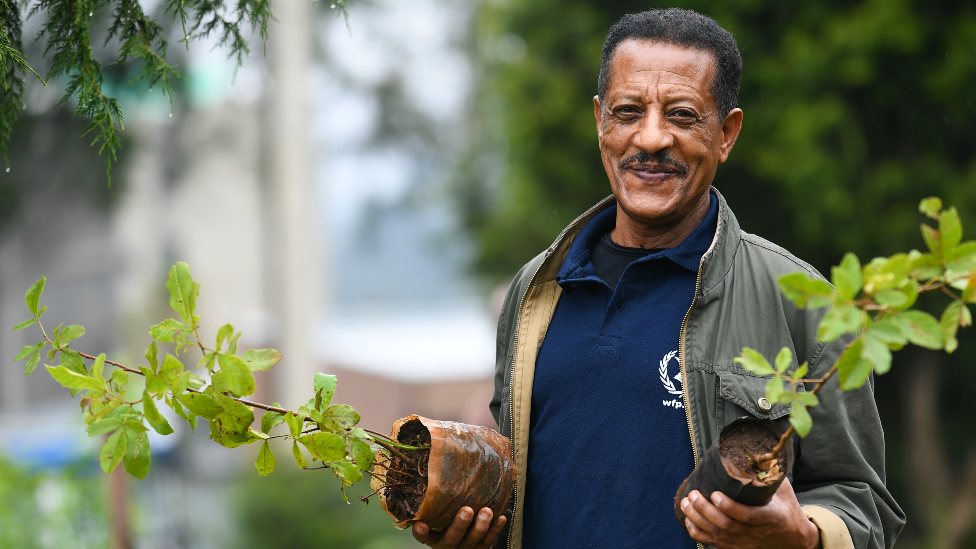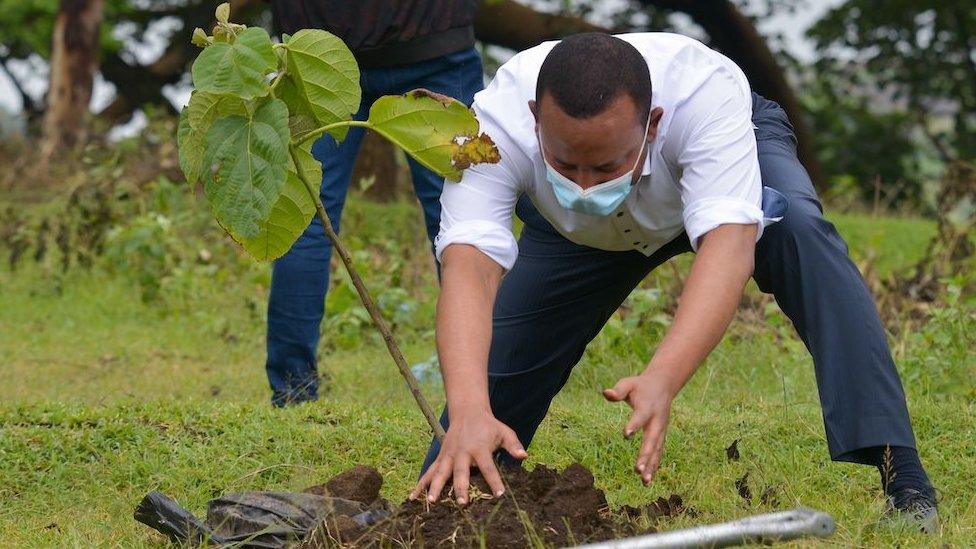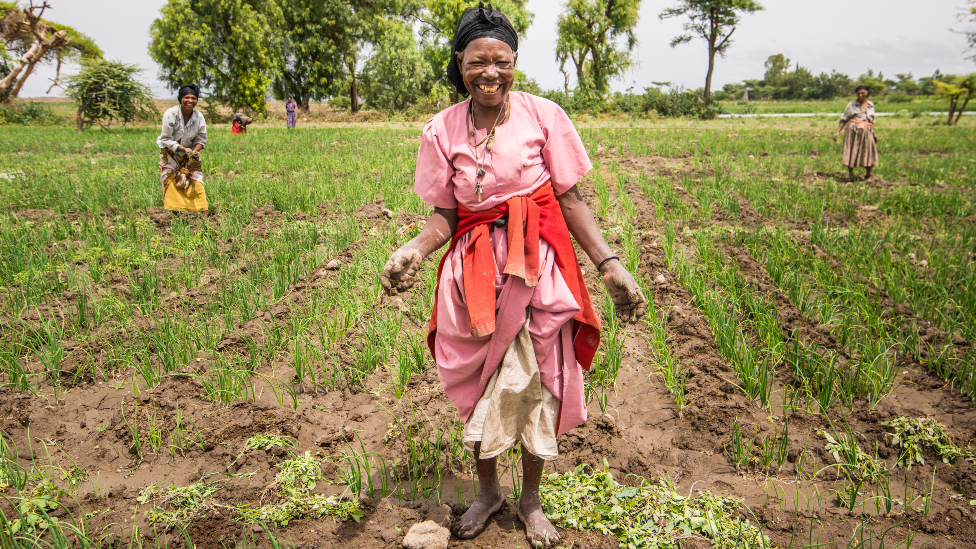COP27: Ethiopia's 20-billion tree goal - a sapling success?
- Published

Ethiopia, which made global headlines in 2019 when it launched an ambitious campaign to plant 20 billion trees by the end of this year, says that goal has already been exceeded - and its arboreal mission is set to continue.
The stats sound impressive - the government even claimed to have planted more than 350 million trees in a single day in 2019.
But in a country battling drought, conflict and a rising population, it is unclear how effective and successful the mass tree-planting has been.
Supporters of the Green Legacy Initiative (GLI), championed by the country's Prime Minister Abiy Ahmed, say it has restored greenery, tackled climate change and improved local livelihoods.
It has certainly raised awareness about deforestation and garnered mass engagement, with 20 million Ethiopians reportedly taking part.
How many survived?
The government-backed GLI Technical Committee puts the average survival rate of seedlings at 83.4% in 2019 and 79% in 2020.

The Green Legacy Initiative is Prime Minister Abiy's pet project
However, those figures may not be reliable, warns James Mayers from the International Institute of Environment and Development (IIED), a London-based think tank.
He told the BBC that the GLI had yet to introduce a formal process for the trees post-planting.
"It's only been a few years and trees take a long time to grow. Survival in the long-term is what matters," he said.
Around the world, similar initiatives have struggled. A study by a group of scientists, published this week by a Royal Society journal, external, shows that half of all trees planted in reforestation projects in Asia do not survive for more than five years.
But Adefires Worku, who co-ordinates the GLI Technical Committee, has faith in their figures, collected from local communities.
"We're hoping to get these verified by independent international bodies," he told the BBC.
Types count
Ethiopia is home to Africa's second-largest population and implementing a countrywide tree-planting operation has not been a simple task.

The planting of native trees is often recommended by forestry experts
A variety of seedlings were used, including agroforestry trees and fruit trees, like avocado and papaya.
"Putting the right species, in the right places, for the right purposes is essential," says forestry expert Lars Graudal from the Kenya-based World Agroforestry Centre, which provides training to the local nurseries in Ethiopia that supply the GLI with seeds.
The GLI did come in for criticism for poor planning in its first year of operation.
Some farmers were only given one day's notice to attend sites and trees were planted in rocky and unsuitable conditions, according to a joint report by IIED and Ethiopia-based Echnoserve Consulting.
It said eucalyptus trees, for example, were "reportedly being planted in areas that could damage the environment".
Eucalyptus trees grow fast and produce more timber and were therefore favoured by some farmers. However, they require a lot of water and can drain soil of vital nutrients, making it harder to grow other crops.
Agroforestry organisations around the world prefer the use of indigenous trees. Essentially, they should be either native, or non-invasive, meaning they benefit the biodiversity of the area.
Exotic trees like eucalyptus can have benefits, but need to be thoughtfully planted and managed.
The GLI has made an effort to introduce more indigenous species like bamboo in recent years.
But exact progress is difficult to measure, as official statistics on the number of exotic versus native trees planted is still not available - though this is something the GLI Technical Committee says it is working on as part of its next analysis.
"Diversification cannot be achieved overnight," Mr Graudal told the BBC, stressing that it would be wrong to focus on the negatives.
"It takes time to get this right. But that should not prevent people from taking action. Ethiopia is building up its resource base to use more native species."
Tom Skirrow, from the charity Tree Aid, says it is important to plant trees that provide actual value, like timber or food, for a local community. This gives farmers an incentive and encourages long-term management.
Another issue that has caused complication for the GLI is the drought - the region's worst in more than 40 years. Some areas have not seen rainfall for more than two years affecting the survival of seedlings.
Beyond that, foresters have had to think carefully about planting drought-resistant trees.
"We need to grow trees that are right, not only for today - but also for tomorrow's climate conditions," Mr Skirrow told the BBC.
While using the wrong type of trees can be detrimental to already stretched water supplies, the right ones can lead to long-term gains.
'Rainmakers'
Jens Kanstrup, a senior adviser at Denmark-based Forests of the World, says re-establishing tree cover helps to maintain humidity.
"At the end of the dry season, communities in agroforestry areas will find that the soil is humid and thriving. Those living in open fields will be completely dried out," he told the BBC.

Trees need to be planted to help, not hinder, farmers
If the right trees are planted they can also increase rainfall in the long-term, says Mr Graudal, citing an Australian study which showed the benefits for water supplies of restoring greenery, external.
The brutal two-year war in Tigray, in northern Ethiopia, has affected the tree-planting scheme.
A peace deal was recently signed, but the GLI has no data for Tigray since 2021 - as the region was blockaded for much of the conflict.
Mr Adefires, who was assigned to launch the GLI in Tigray, remains hopeful.
"Tigray was home to many successful landscape restoration activities, even before the GLI," he said.
"If the deal goes through, I'll be the first man to return to Tigray and check on our nurseries."
The Great Green Wall
The GLI also forms part of another ambitious scheme - the pan-African Great Green Wall project.
The initiative was launched in 2007 by the African Union, with the aim of creating an 8,000km (nearly 5,000-mile) tree barrier stretching from Senegal to Djibouti by 2030, to halt the southward spread of the Sahara desert.
Despite receiving mass-funding from foreign donors, it has struggled to achieve quick success. By 2017 best estimates suggested it had only reached 15% of its target - the worst put it at 4%.
According to the UN, the aim of the Green Wall project has now changed from planting a giant structure to creating a "mosaic of restoration projects across the continent".
To this end, Ethiopia has now made the largest pledge, promising to produce five billion seeds over 58 districts.
Tree Aid, which works with both the Green Wall and the GLI, say both projects show high-level political backing and must work alongside low-level community engagement for long-term success.
"There are many pitfalls with mass tree-planting. But we need to come together to support ambitious projects like the GLI," says Mr Skirrow.
"We must share learnings, learn from our failings and improve together."
You may also be interested in:
In northern Ethiopia, churches are fighting to protect their sacred forests